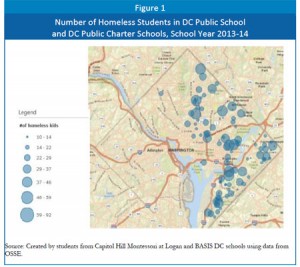DC’s high housing costs create challenges for families that make it hard for their children to succeed in school. When families move frequently from home to home or become homeless, it can disrupt the continuity in a child’s education. Homelessness, in particular, leads to child anxiety, depression, and withdrawal that can result in poor educational outcomes. This means that meeting the special needs of homeless students is an important part of improving school outcomes in the District.
Today, DCFPI is releasing the third part of its series examining the impact of poverty on educational outcomes and the services that can mitigate the negative impacts. Today’s brief focuses on services for the 4,000 students in DC Public Schools who are homeless, a number that has grown 37 percent in two years (See Figure 1.) In some schools, as many as one-fourth of the students are homeless, and one in eight schools has a student homelessness rate of over 10 percent.
With federal funding to assist homeless students falling — now equal to just $35 per homeless student in DC — it is important for the District to take steps to examine its locally funded efforts and improve services so that homeless students have the supports they need. The FY 2015 budget includes a good start — an additional $200,000 to increase outreach efforts — but it is likely that more investments are needed.
The federal McKinney-Vento program is the main way that DC and states provide services to homeless students. The program sets important goals, such as providing transportation so that students can remain at their school of origin, helping students enroll in school quickly, identifying homeless youth, and providing financial assistance for things like field trips and graduation fees. But with limited funding, it is unlikely the District can support all of these goals in a meaningful way.
Given the complexities of barriers facing homeless students, it is important that the District assess the adequacy of these services and expand them if needed. This includes additional support for homeless liaisons in schools so that they are better able to meet the needs of a rising homeless youth population.
In addition, a system-wide needs assessment is needed to identify gaps in services and allow the city to develop a comprehensive set of tools to help schools quickly remove barriers for homeless children. The District should expand outreach to ensure students and families who become homeless know of the assistance that is available to them. The FY 2015 budget takes a step in that direction, by adding two staff positions in the Office of the State Superintendent of Education, but it is not clear whether that will be sufficient. Lastly, the District should invest in programs that help prevent families from becoming homeless in the first place. The Family Stability Program in Baltimore, for example, locates staff in schools to help families at risk of homelessness.
To read the complete brief, click here.
To print a copy of today’s blog, click here.

